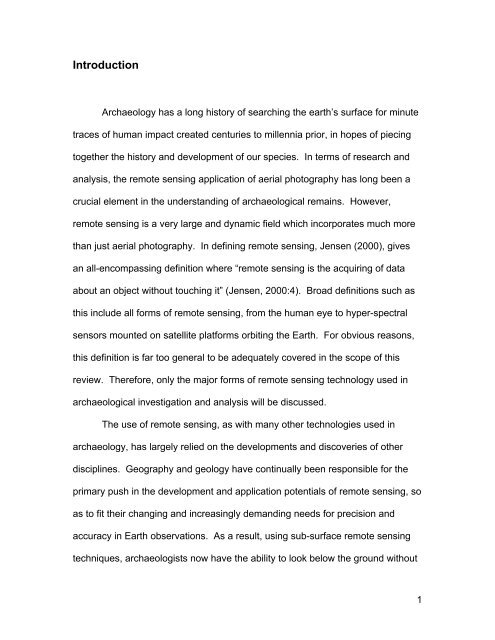A Review of Remote Sensing Application in Archaeological Research
A Review of Remote Sensing Application in Archaeological Research
A Review of Remote Sensing Application in Archaeological Research
Create successful ePaper yourself
Turn your PDF publications into a flip-book with our unique Google optimized e-Paper software.
Introduction<br />
Archaeology has a long history <strong>of</strong> search<strong>in</strong>g the earth’s surface for m<strong>in</strong>ute<br />
traces <strong>of</strong> human impact created centuries to millennia prior, <strong>in</strong> hopes <strong>of</strong> piec<strong>in</strong>g<br />
together the history and development <strong>of</strong> our species. In terms <strong>of</strong> research and<br />
analysis, the remote sens<strong>in</strong>g application <strong>of</strong> aerial photography has long been a<br />
crucial element <strong>in</strong> the understand<strong>in</strong>g <strong>of</strong> archaeological rema<strong>in</strong>s. However,<br />
remote sens<strong>in</strong>g is a very large and dynamic field which <strong>in</strong>corporates much more<br />
than just aerial photography. In def<strong>in</strong><strong>in</strong>g remote sens<strong>in</strong>g, Jensen (2000), gives<br />
an all-encompass<strong>in</strong>g def<strong>in</strong>ition where “remote sens<strong>in</strong>g is the acquir<strong>in</strong>g <strong>of</strong> data<br />
about an object without touch<strong>in</strong>g it” (Jensen, 2000:4). Broad def<strong>in</strong>itions such as<br />
this <strong>in</strong>clude all forms <strong>of</strong> remote sens<strong>in</strong>g, from the human eye to hyper-spectral<br />
sensors mounted on satellite platforms orbit<strong>in</strong>g the Earth. For obvious reasons,<br />
this def<strong>in</strong>ition is far too general to be adequately covered <strong>in</strong> the scope <strong>of</strong> this<br />
review. Therefore, only the major forms <strong>of</strong> remote sens<strong>in</strong>g technology used <strong>in</strong><br />
archaeological <strong>in</strong>vestigation and analysis will be discussed.<br />
The use <strong>of</strong> remote sens<strong>in</strong>g, as with many other technologies used <strong>in</strong><br />
archaeology, has largely relied on the developments and discoveries <strong>of</strong> other<br />
discipl<strong>in</strong>es. Geography and geology have cont<strong>in</strong>ually been responsible for the<br />
primary push <strong>in</strong> the development and application potentials <strong>of</strong> remote sens<strong>in</strong>g, so<br />
as to fit their chang<strong>in</strong>g and <strong>in</strong>creas<strong>in</strong>gly demand<strong>in</strong>g needs for precision and<br />
accuracy <strong>in</strong> Earth observations. As a result, us<strong>in</strong>g sub-surface remote sens<strong>in</strong>g<br />
techniques, archaeologists now have the ability to look below the ground without<br />
1
















